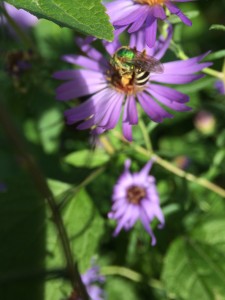
Parkways: those areas between the sidewalk and the street tend to be after-thoughts or the places where we plant trees, but they could be so much more. They could be solutions to flooding, declines in biodiversity, tree stress, and climate change. Sound implausible? Perhaps for one parkway garden, but if we transformed our drab parkways into places of evolving color and texture, we could make a huge impact on some of the environment’s biggest problems. Let’s crowd-source solutions to environmental problems.
Native Plants as Environmental Problem-Solvers
Native plants and healthy soils can help with mitigating flood water. Together, plants’ deep roots and healthy soil biodiversity create channels and porosity, helping water move through the soil. The benefits of healthy soil don’t stop there: the “glue” in the aggregates created by earthworms, bacterial slime, and fungal hyphae hold water as well, and bring water to the parkway tree and to the gardens. Trees form beneficial relationships with fungi.
The Chicago region lost a great deal of biodiversity through its development and use of lawns; however, we can regenerate biodiversity through the use of native plants. Many of our native plants have extensive root systems (2/3 of many plants are actually in the roots), and the plants pull down carbon and when some of the plants’ roots die each year, the carbon remains buried underground.
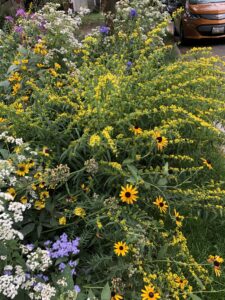
The Problem with Lawns
The standard bluegrass lawn cannot really do any of these things to the same extent. Many residents use pesticides and fertilizers which destroy soil biodiversity and pollute the air and water. Often, the soil under the lawn is compacted, and given the structure of the dense layer of the turf grass and the short root system, water actually runs off the parkway and into the streets and then on into the sewer system.
How to Switch from Lawn to Native Garden
There is a beautiful, simple, and inexpensive fix to these issues, and that is simply putting a planting on your parkway. It can be simple, just one species of sedge or a mix of low sedges and a couple of flowering species, such as geraniums or blue mist, or you can put in as many species as you want (for all you collectors out there; I’m one!) Or you can go all out and have a bioswale created on your parkway (but use caution if you have large established trees, the extensive digging can damage or destroy the tree).
We’ve put a list together for you to get started. If you go to our Resources page, you can check out some of the online retailers, who have low-growing mixtures, or you can do a restricted search for plants under a certain height so that you can find the plants just right for you.
Requirements of the Village
Below is a list of plants that are easy to grow and can tolerate some salt and are sun/soil adaptable and grow low (under the 30″ required by the Village of Oak Park). Those with uncertain salt tolerance are marked with an *. Depending on how much salt your street receives, you may want to plant them closer to the sidewalk than to the curb. Salt-tolerant plants often are able to deal with some dog urine (something we need to think of realistically in our village; perhaps organizing a space for them using a rock or some crushed stone is a good idea. Better to direct them than to lose your Bluebells that were just about to bloom).
Considerations for Getting Started
If you plant under a tree, plant away from the trunk and plan for the spread so that foliage doesn’t abut the trunk and create a possible environment that would contribute to disease to the tree (bark that remains constantly damp can become weak over time). We recommend small seedlings or small plugs to avoid too much digging which can damage tree roots, particularly in large, established trees. You can also use the method of lasagne beds to create a new garden, and that is best done in the fall (so that the materials can decompose, and you can plant in the spring), and again should be done several feet away from the tree’s trunk. See our post “Getting Started with a Native Garden,” which illustrates the lasagne method.
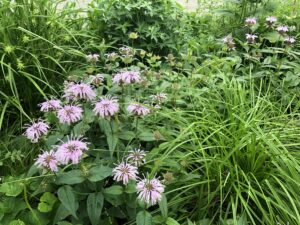
The sun conditions on your parkway will be determined by the maturity of the tree and where the sun comes in. Your parkway may get a lot of sun if it is south facing. Plants that do well in shade might be planted closer to the tree (please make sure though to keep a couple of feet of space away from the tree trunk itself, which ideally has a layer of mulch around it) while those that prefer more sun might be planted farther away from the tree. This style would mimic what can happen in the openings in a woodland or savanna setting (our area was savanna pre-settlement, a mix of trees, grasses, and flowering plants). You can be formal in your design or allow a more naturalistic flow and allow your plants to disperse themselves over time.
The garden, in general, will be less maintenance than a lawn. Please note, there will be some maintenance, particularly in the beginning, but over time there will be very little. A moderate amount of fall and spring clean-up (the conventional scorched earth method should not be used, counter-productive and ecologically damaging).
Those with uncertain salt tolerance are marked with an *.
Prairie Plants for Full Sun – If you don’t have a parkway tree or have sunny spots in your yard.
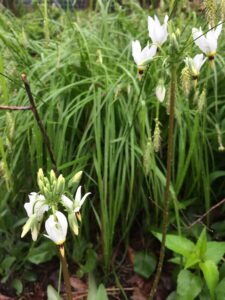
–Aster oblongifolius – Aromatic Aster
–Amorpha canascens – Lead Plant
–Asclepias tuberosa – Butterfly Weed (milkweed)
–Baptisia bracteata–Cream Wild Indigo*
–Coreopsis palmata–Prairie Coreopsis
—Dodecatheon meadia–Shooting Star
–Dalea purpurea – Purple Prairie Clover
–Geum triflorum* – Prairie Smoke
–Liatris cylindracea – Dwarf Blazingstar
—Oenothera pilosella* – Prairie Sundrops
–Penstemon digitalis – Foxglove beardtongue
–Phlox pilosa* (full sun)–Praire Phlox
–Rudbeckia species (select straight native species)
–Ruellia humilis – Wild Petunia
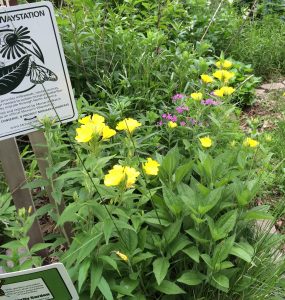
–Silene regia* – Royal Catchfly
–Blephilia ciliata–Downy Wood Mint
–Callirhoe bushii–Wine Cups–spreading, could be treated as a ground cover.
—Chamaecrista fasciculata–Partidge Pea, one of our few native annuals; an absolute delight; it has beautiful yellow bloooms, delicate foliage (closes at night), and is a great pollinator plant; may also host sulphur butterflies
–Native grasses like Prairie Dropseed or Purple Love Grass
Savanna Plants for Part Sun – If you have a parkway tree but it is tall or does not shade the whole area, or for parts of your yard that get at least a half day of sun. (Many of the above plants could be used if you have closer to 4-5 hours of sun.)
–Anemone canadensis – Meadow Anemone (full-part sun) (can be an aggressive spreader so is best as a groundcover, perhaps mix with some grasses or ferns for a lovely woodland setting feel)
–Aster laevis – Smooth Blue Aster (can be trimmed by July 4th to keep compact and small)
–Aster ericoides – Heath Aster (bushy low habit, many small white flowers in the fall)
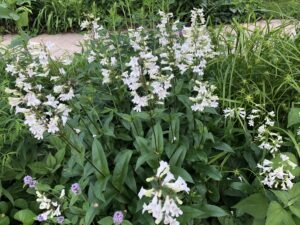
–Allium canadense
–Allium cernuum – Nodding Wild Onion
–Aquilegia canascens – Wild Columbine
–Geranium maculatum* – Wild Geranium
–Native grasses/carexes
–Penstemon digitalis–Foxglove beardtongue
–Carex grayi*
–Carex brevior*
Woodland Plants for Mostly Shady Areas – If you have a parkway tree with a low/large/dense canopy. These need at least a few hours of sun but like shade, especially in the afternoon.
–Hydrophyllum virginianum * –Virginia Waterleaf
–Mertensia virginicum*- Virginia Bluebells –(part shade needed, best under a mature tree and shade in afternoon)
–Phlox divarticus*; needs a moist soil
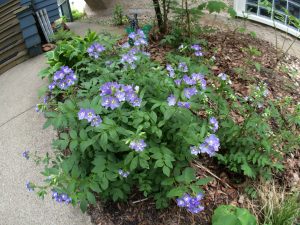
–Polemonium repetans*–Jacob’s Ladder
–Polystichum acrostichoides*–Christmas fern
–Rudbeckia hirta – Black-eyed Susans
–Silene stellata*–Starry Campion
–Solidago caesia –Blue-stemmed Goldenrod
–Thalictrum dioicum*–Early Meadow Rue
–Tiarella cordifolia–Foam flower
–Zizea aurea – Golden Alexanders (can be an aggressive spreader; host for Eastern Black Swallowtail)
–Viola species
–Native grasses such as:
Carex blanda (evergreen sedge)–Common Wood Sedge
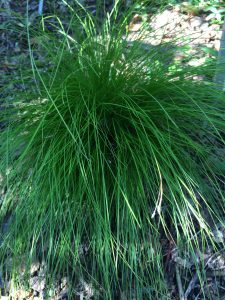
Carex rosea–Curly-styled Sedge
Carex pennsylvanica–Penn Sedge
Carex sprengelii–Long-beaked Sedge (adaptable, will grow in a variety of sun conditions, drought tolerant)
Carex eburnea–Ivory Sedge
In May 2024, we had a presentation on Parkway Gardens from two experienced native plant gardeners:
Sources:
http://www.midwestgroundcovers.com/page/Salt_Tolerant_List
http://www.wildonesrrvc.org/Documents/Misc/Salt_Tolerant_Natives.pdf
